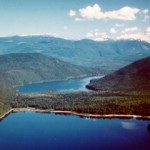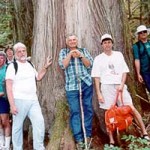 In the summer of 1992, SEAS members and friends blazed a trail from Wright Creek on the Seymour Arm of Shuswap Lake past Wright Lake and on to Hunakwa Lake. Although this trail is likely grown over now, the route still exists and it is one of four routes into the park. Boaters can now beach their boats at the mouth of Wright Creek and hike into the park, although they will be crossing a logging road.
In the summer of 1992, SEAS members and friends blazed a trail from Wright Creek on the Seymour Arm of Shuswap Lake past Wright Lake and on to Hunakwa Lake. Although this trail is likely grown over now, the route still exists and it is one of four routes into the park. Boaters can now beach their boats at the mouth of Wright Creek and hike into the park, although they will be crossing a logging road.
The negotiations that preceded the creation of the park resulted in a compromise that allowed Federated Co-op to extend the Beach Bay logging road through the western edge of the park to access timber on the west side of the Anstey Pennisula. This road also provides access into the park, although there is a gate that prevents vehicle access during times (such as weekends and holidays) when there is no industrial use. The best alternative to walking the approximately 5 kilometres of logging road, is to bring mountain bikes for this section. Hikers can reach Wright Lake by heading east through a fairly open forest from just past a large landing adjacent to the road. A good trail exists along the western edge of Wright Lake. Heading north around the lake, the trail ends up at the remains of an old trappers cabin in a grove of large, old growth cedar trees. Hikers will be able to appreciate the amazing diversity of plants and wildlife in this wetland area.
The best way to reach Hunakwa Lake is by boat into Anstey Arm and then hiking along the 3-kilometre BC Parks trail that begins on the west side at the end of the arm. This trail follows the west side of Hunakwa Creek through an old growth cedar-hemlock forest. Hikers may catch sight of one of the resident beavers near the beaver dam that is close to the lake. As well, there are often ducks and geese in the creek, and an abundance of wildflowers and huckleberries. Some of the cedar trees have been “culturally modified” as evidenced by the scars where bark was removed centuries ago by natives who camped in the area.
 Where the trail reaches Hunakwa Lake, there is a small campsite area, where SEAS has left a fibreglass canoe for visitors to use. During the summer, the lake is very warm and good for swimming, although there are some leeches so it is best to avoid walking on the bottom of the lake. Across from the campsite is a small island where one can often see eagles nesting in the large snag. Hunakwa Lake is also home to many families of loons, whose calls reverberate through the hills – hence the name Hunakwa- which means “echo” in the Shuswap language. One of the reasons that the lake is so quiet is that the fishing is poor because the lake is shallow and filled with suckers, although there are some trout in the lake.
Where the trail reaches Hunakwa Lake, there is a small campsite area, where SEAS has left a fibreglass canoe for visitors to use. During the summer, the lake is very warm and good for swimming, although there are some leeches so it is best to avoid walking on the bottom of the lake. Across from the campsite is a small island where one can often see eagles nesting in the large snag. Hunakwa Lake is also home to many families of loons, whose calls reverberate through the hills – hence the name Hunakwa- which means “echo” in the Shuswap language. One of the reasons that the lake is so quiet is that the fishing is poor because the lake is shallow and filled with suckers, although there are some trout in the lake.
One can follow the shoreline along the west side of the lake, through some stands of old growth fir, pine, cedar and hemlock trees to a small creek about one third up the lake. This creek leads to a small pond created by beavers that left, after munching up all the deciduous trees in the area. This pond is covered by a floating layer of moss so thick that it is possible to walk on, a strange sensation indeed. From this pond, it is possible to hike down to Wright Lake and then to the Seymour Arm of Shuswap Lake or to the Beach Bay access road.
Most visitors to this park enjoy the beautiful sandy beach at the end of Anstey Arm for swimming and camping. Behind this beach, one can find many old depressions in the ground that are all that remain of the kickwillies where Shuswap Indians once lived. The Anstey River is another feature in the area, but hikers will face having to scramble over the many deadfalls when hiking along the river.
There is only one very rough, 4×4 road into Hunakwa Lake from the north end. This “goat track” was bulldozed in the late 1960s to fight a fire and local residents keep it open. This road begins just past a creek that crosses the Beach Bay logging road and it passes east then south through private land. There is no guarantee that it is open for public use, but it does however, provide the only way to bring canoes into the lake.